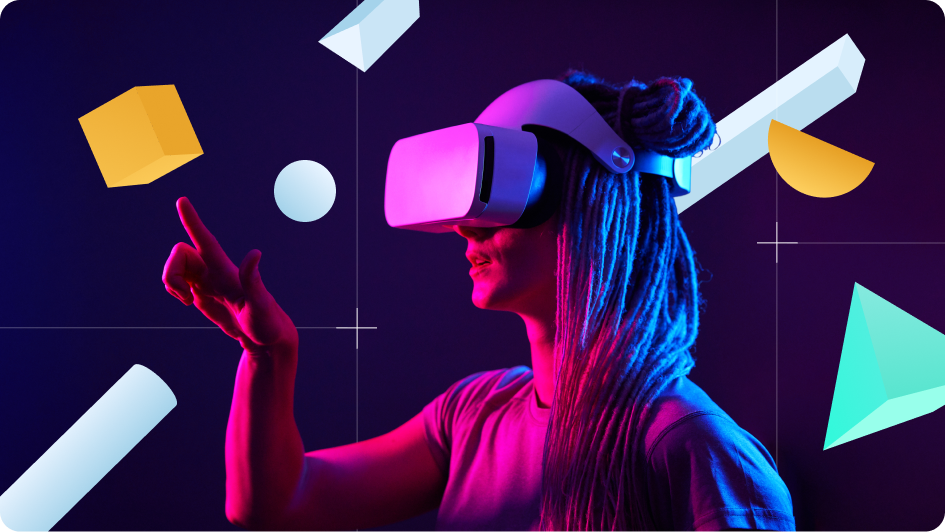As we enter a new year, the design industry is buzzing with predictions about upcoming UI/UX trends. These trends are shaped by evolving user expectations, technological advancements, and shifts in the digital landscape. After reviewing various articles, it is clear that 2025 is all about focusing on user-centered personalization and customization, blurring the lines between the digital and physical worlds, and creating accessible digital tools built for the future.
While we don’t recommend adopting trends for the sake of being trendy, it’s valuable to understand the visual elements and user experiences that will likely resonate with audiences in the coming year. Staying informed helps ensure your brand, website, and digital experiences remain relevant while providing opportunities to stand out from the competition. Below is a compilation of UI/UX design trends expected for 2025, along with key considerations before embracing each one.
Motion & Animation
If your website is static, it likely looks outdated. Motion graphics and animations, such as parallax scrolling and micro-animations, are subtle interactions that can significantly impact the user experience. Micro-interactions, like hover effects and loading indicators, provide feedback to guide users through their journey while creating moments of surprise and delight. Advanced animations and scrolling techniques can tell a compelling story, engage users, and add sophistication—perfect for helping users focus and combat short attention spans.
Motion and animations provide many benefits, but it’s important to strike the right balance. When incorporating motion and animation into your website or digital experience, be intentional. Focus on adding depth and context to enhance understanding and foster an emotional connection to your brand. Overusing animations can overwhelm users, hinder navigation, and negatively impact load times. Aim for purposeful motion that enriches the user experience without compromising usability.
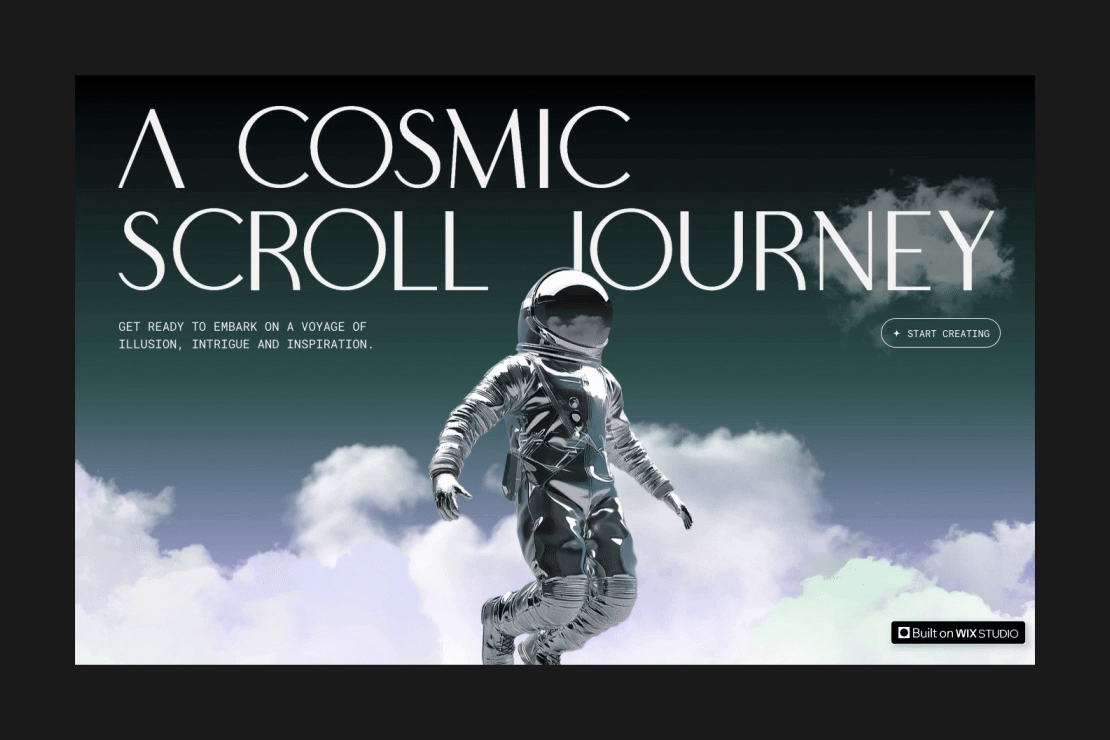
Parallax scrolling. Source: WixStudio
Immersive Experiences
VR, AR, and 3D animations are revolutionizing UI by delivering immersive, intuitive user experiences. By incorporating depth, perspective, motion, and sound, these technologies enable users to navigate environments more naturally, engage deeply, and gather information in realistic and meaningful ways. This trend is most useful in retail, gaming, and education.
These immersive experiences are not only fun and visually captivating but can also increase interactivity and engagement. For instance, they can improve online shopping experiences by allowing users to view products from all angles or be useful in education by conveying complex information in an easily digestible way. These features often result in higher user satisfaction and retention. However, they should only be adopted when they add intentional value to the end user and justify the investment.

Source: IKEA’s Place App
AI Integration
There is no denying that artificial intelligence (AI) has become deeply integrated into our everyday lives, and its role in UX continues to evolve. Leveraging AI in the creation process is becoming increasingly common, helping improve products and services and accelerate design processes. AI can automate tasks like graphic generation, prototype building, and conducting research, allowing designers to focus on strategic thinking and problem-solving.
For end users, AI integration enhances the experience by making it more seamless, personalized, and helpful. AI algorithms can analyze user behavior data to identify patterns and trends that influence the optimization of user flows and navigation. Advancements in machine learning take personalization even further, allowing designers to tailor content, product recommendations, and services to align with user preferences and interests.
Adaptive interfaces powered by AI can dynamically adjust to user behavior or environmental factors, such as modifying layouts or font sizes based on screen size. Additionally, AI-driven chatbots and virtual assistants can provide quick, intelligent support, creating smoother and more human-like interactions.
The capabilities of AI are fascinating. However, integration raises important considerations, particularly around privacy and the ability to differentiate between AI- and human-generated content. Privacy concerns can be addressed through transparent consent and ethical data collection practices. Embracing transparency by acknowledging AI’s role in your process and giving appropriate credit fosters trust and integrity. We are living in exciting times and are all navigating this new era of creativity together. It’s important to focus our efforts on enhancing user experiences and improving our daily lives using ethical and transparent practices—not just utilizing new technology because it exists.
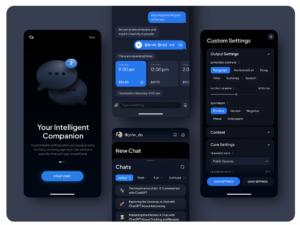
AI Prompt Assistant. Source: Conceptzilla
Bento Grids
Yes, just like it sounds, the bento grid is inspired by the Japanese Bento Box. These modular designs allow designers to combine content blocks of varying sizes while maintaining a clean, organized layout. Bento grids are particularly effective in data-heavy applications such as analytics tools and project management platforms, where organization is key, large amounts of information need to be digested at once, and user control and customization are priorities.
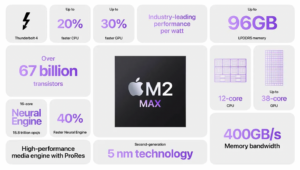
Bento Grid. Source: Apple
This modular grid approach offers scalability and flexibility, making it ideal for integrating diverse content and adapting seamlessly to multiple devices. Strategic use of color and box size can help create a visual hierarchy that is visually satisfying while allowing the user to navigate and explore intuitively without being overwhelmed.
Morphism
Skeuomorphism emerged in the late 20th century to help familiarize users with the digital world by incorporating real-world textures and graphics into interfaces. As users grew more accustomed to digital interactions, design trends shifted toward a flatter UI design for simplicity and clarity. However, as we move further into a digital era that continues to blur the lines between digital and physical experiences, skeuomorphism is making a comeback with a modern twist.
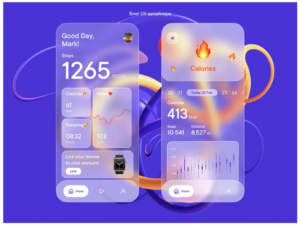
Glassmorphism. Source: Dribbble
The updated skeuomorphism, called neumorphism, is subtler, blending flat design principles with softer shadows and gradients, creating a more polished look. Variations of this design style that are popular right now include glassmorphism (resembling frosted glass combined with floating objects) and claymorphism (featuring 3D rounded, soft shapes). These modern 3D graphics can create a sense of realism and depth while remaining sleek and sophisticated. By bridging the digital and physical worlds, these design elements harmonize well with other emerging technologies such as VR/AR immersive experiences mentioned above.
Minimalism
It’s no surprise that clean, uncluttered interfaces make it easier for users to find what they are looking for. Minimalism has been a trend in UI/UX design for years, with each iteration subtly evolving the timeless principle: less is more.
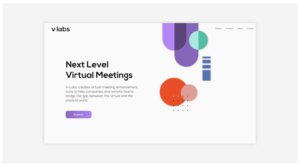
Minimalist website design. Source: vlabs
Clean layouts featuring airy, negative space that focus on essential functionality and features can be elevated by incorporating asymmetry, interactivity, and strategic pops of color to draw attention to what is most important. In addition to being easy to use and elegant, simple layouts also load faster and perform better, making it easier to complete tasks efficiently. When incorporating minimalism into your digital experiences, ensure the design remains intentional, reflects your brand’s personality, and fosters an emotional connection with users.
Zero UI
This trend takes minimalism to the next level by incorporating no visible UI at all. As interfaces become more intuitive, the shift toward “invisible” UI emphasizes gesture- and voice-based controls that minimize on-screen elements, creating a seamless, integrated experience that fits naturally into daily life.
Voice User Interfaces (VUIs) allow users to interact with devices and access information using voice commands which, according to statistics, is a functionality already adopted by a majority of smartphone users. This has likely grown in popularity due to convenience and as people seek to spend less time looking at their devices. Further driving their adoption, with advances in AI and Natural Language Processing (NLP), voice interfaces are becoming more accurate and capable of handling nuanced user requests making this form of digital interaction more conversational and human. VUIs offer numerous high-value benefits including simplifying complex tasks, enabling hands-free interactions while engaging in other activities, and improving accessibility for individuals with disabilities.
VUIs can definitely make our lives easier, however, privacy concerns must be taken into consideration. Voice assistants often collect and process sensitive data, such as locations and phone numbers, requiring the implementation of security measures and obtaining user consent. To meet diverse user needs, it’s also important to ensure smooth transitions between voice and touch controls providing users the freedom to choose how they interact with your interface.
Silent Authentication
Remembering and entering passwords is overwhelming and annoying. Silent authentication has evolved from a trend to an expectation, offering a seamless way to verify users in the background through technology features like fingerprint scans, facial recognition, device memory, and single sign-on.
This allows users to remain immersed in their experience without the need for active authentication. They are recognized for who they are and reassured by built-in security allowing them to continue on their user journey with peace of mind and without interruption.
Silent authentication is especially valuable for security-critical applications such as banking, e-commerce, and social media platforms. However, as technology evolves and the lines between industries continue to blur, the demand for convenient experiences like silent authentication is becoming universally and appreciated across a wider range of user experiences in various industries.
Dark Mode
This trend has become more of a necessity than simply a design preference. Many apps and operating systems offer built-in dark mode options to protect users’ eyes from harmful blue light, reduce eye strain in low-light conditions, and assist individuals with visual impairments and light sensitivity. Beyond its health benefits, dark mode is also eco-friendly because it consumes less power, and allows users to engage with screens for longer periods, potentially increasing interaction with your digital environment. Consider incorporating dark mode into your digital experiences in a way that thoughtfully aligns with your brand and benefits your users—making your digital tools more accessible.
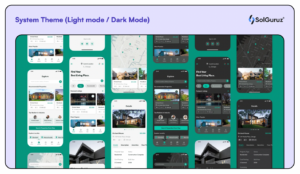
Light mode vs. dark mode. Source: SolGuruz
Personalization
Statistically, a majority of consumers prefer engaging with a brand that offers personalized recommendations and tailored experiences. In 2025, personalization is all about creating customized, seamless user experiences that are so intuitive that users may not even notice the effort behind the screens.
Effective personalization aligns visual elements with context, making digital experiences feel effortless and relevant. AI-powered systems can enhance this process by suggesting content, modifying navigation options, and adjusting layouts based on factors like user behavior patterns, location, time of day, and device type. Predictive UI takes personalization further, using machine learning algorithms to anticipate user actions—offering autofill suggestions before a user even clicks.
Additionally, customizable dashboards and user-controlled layouts are becoming increasingly popular, empowering users to organize information and resources according to their specific needs and workflows. These features collectively create a natural, intuitive, and helpful user experience, benefiting your organization by increasing user satisfaction, fostering brand loyalty, and driving faster conversions.
However, once again, data-driven personalization raises important concerns about privacy, consent, and data misuse. Transparency is key to building trust and to address these concerns, it’s crucial to provide users with the option to opt out of personalization features if they have reservations about how their data is being used.
Inclusivity & Accessibility
As more of our day-to-day activities move online, it becomes increasingly important to create a world that is accessible to everyone, regardless of their abilities.
Designers must continue to develop interfaces that prioritize visual, auditory, cognitive, physical, and cultural inclusivity. Standards such as keyboard-friendly navigation, high color contrast, and alternative text for screen readers help support visually impaired users. Cognitive accessibility can be enhanced through clear navigation, consistent layouts, and options to minimize distracting elements like excessive animations. Cultural inclusivity can be achieved through language customization, consideration of cultural norms, appropriate imagery, and awareness of user expectations across different regions. By designing with all users in mind, doors may be opened to new markets and demographics that may have not been previously considered.
This fosters a sense of inclusion and empowerment, leading to greater user engagement, increased conversions, and customer loyalty. Accessibility is not merely a design trend, but a fundamental human standard that makes our world more usable, understandable, and enjoyable for everyone.
Sustainable & Ethical Design
In 2025, there will be an increasing focus on digital products that are not only user-friendly but also environmentally responsible, driven by a heightened awareness of climate change and the need for sustainable practices. Eco-friendly design choices, ethical data use, and timeless design principles will prioritize creating interfaces that promote energy efficiency, responsible consumption, and reduce waste.
Optimizing interfaces for mobile devices and offering dark mode options, can help conserve energy and reduce the frequency with which users need to charge their devices. Compressing images, using efficient file formats, and powering data centers with renewable energy sources all contribute to reducing carbon footprints.
Furthermore, incorporating features that encourage environmentally friendly behavior can inspire your users to take part in a more sustainable future while resonating with eco-conscious audiences. Sustainable design not only helps organizations contribute to a greener world but also improves user experience while ensuring relevance and ethical practices.
Conclusion
As we step into 2025, it’s evident that UI/UX design is heading toward a future that prioritizes user-centered experiences, inclusivity, sustainability, and seamless integration of advanced technologies. From immersive experiences powered by AR and AI to timeless principles like minimalism and accessibility, the trends shaping this year are about more than just aesthetics—they aim to create meaningful, functional, and responsible digital interactions.
However, while it’s exciting to explore these trends, it’s essential to approach them thoughtfully. Not every trend will align with your brand’s goals or resonate with your audience. Success lies in understanding your users’ needs, aligning trends with your unique vision, and implementing changes that enhance usability without compromising functionality or ethics.
By staying informed and intentional, you can leverage these trends to create digital experiences that not only captivate but also inspire trust, loyalty, and engagement. The future of design is here—let’s embrace it with purpose and creativity.


